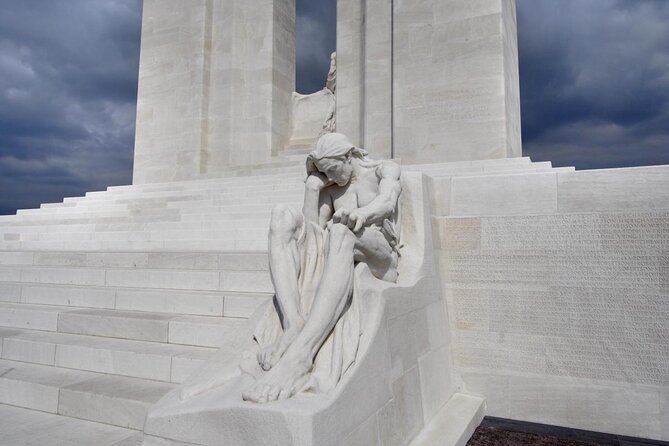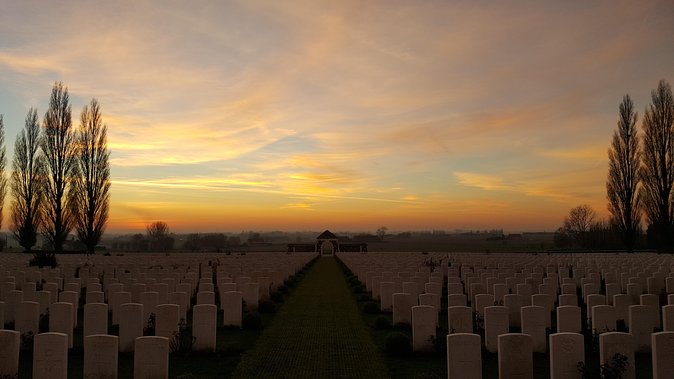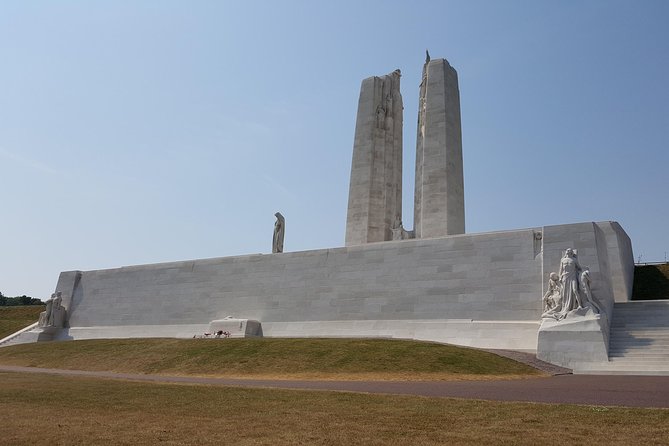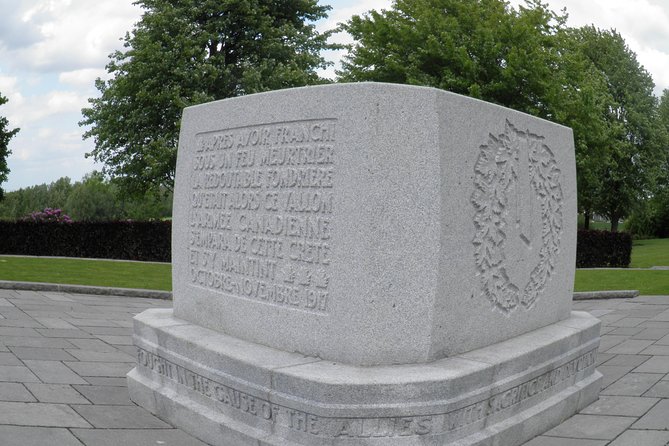Exploring the historic battlefields of Vimy and Flanders is a powerful experience for any traveler interested in Canada’s World War I legacy. This tour from Lille takes visitors through the preserved trenches and memorials that bear witness to the nation’s bravery and sacrifice. From the iconic Vimy Ridge to the emotive Last Post Ceremony at Menin Gate, knowledgeable guides provide a compelling narrative that transports participants back in time. For those seeking a profound connection to Canada’s wartime history, this immersive journey offers a moving and unforgettable encounter.
Key Points

- Comprehensive private tour of Canadian WWI battlefields in France and Belgium, including Vimy Ridge, St Julien Memorial, Tyne Cot Cemetery, and the Menin Gate.
- Explore preserved trenches and tunnels at Vimy Ridge, significant to the 1917 Canadian offensive, with insightful historical context from a knowledgeable guide.
- Visit the Tyne Cot Cemetery, the largest Commonwealth war cemetery globally, and attend the Last Post Ceremony at the Menin Gate in Ypres.
- Air-conditioned minivan transport with hotel pickup and drop-off in Lille or Arras, ensuring a personalized and comfortable experience.
- Minimum of two participants required for booking the private tour, which offers an exclusive and immersive exploration of Canada’s role in World War I.
Tour Overview

This private full-day tour takes visitors to the renowned Canadian World War I battlefields in France and Belgium, departing from either Lille or Arras.
Explorers will explore the preserved tunnels and trenches of Vimy Ridge, the site of a crucial 1917 Canadian assault. The flexible itinerary allows for personalized experiences based on group preferences, visiting significant sites such as Hill 145 memorial, St Julien Memorial, Tyne Cot Cemetery, and the Last Post Ceremony at Ypres’ Menin Gate.
With air-conditioned minivan transport, a knowledgeable guide, and the option to purchase drinks, this tour provides an immersive and memorable journey through Canada’s World War I history.
You can also read our reviews of more tours and experiences in Lille.
Itinerary Highlights

Visitors begin their tour by walking through Vimy’s preserved trenches and tunnels, exploring the site of a notable 1917 Canadian offensive at Hill 145.
The tour then continues to key Belgian WWI sites, including:
- The St Julien Canadian Memorial, where the first German gas attacks occurred.
- Tyne Cot Cemetery, the largest Commonwealth war cemetery in the world and the site where John McRae wrote his famous poem ‘In Flanders Fields.’
- The Menin Gate in Ypres, where the group attends the poignant Last Post Ceremony, a daily tribute to the fallen.
Throughout the day, the knowledgeable guide provides insightful historical context, creating a meaningful and memorable experience for all.
Tour Details
The tour includes air-conditioned minivan transport, with hotel pickup and drop-off available in Lille or Arras.
Throughout the day, the knowledgeable guide provides insightful historical context, complemented by bottled water and the option to purchase alcoholic drinks.
The private nature of the tour ensures your group has a personalized experience, exploring the preserved trenches and tunnels of Vimy Ridge and visiting significant sites like Hill 145, the St Julien Canadian Memorial, and Tyne Cot Cemetery.
The tour culminates with the poignant Last Post Ceremony at Ypres’ Menin Gate, a fitting conclusion to this immersive journey through the Canadian battlefields of the First World War.
Participant Information

A minimum of two people per booking is required for this private Vimy and Flanders Fields battlefield tour.
The tour isn’t wheelchair accessible, but it’s stroller accessible. Service animals are permitted, and most travelers can comfortably participate in the immersive historical experience.
This exclusive tour ensures your group will have the guide’s undivided attention as you explore the sites of significant Canadian offensives during World War I.
Key details for participants include:
- The tour isn’t suitable for wheelchair users, but strollers are permitted.
- Service animals are allowed on the tour.
- Most travelers will be able to fully participate in the memorable experience.
Reviews and Feedback

With a perfect rating of 5 stars from 9 reviews, the Vimy and Flanders Fields battlefield tour has earned overwhelmingly positive feedback.
Participants consistently praise the knowledgeable guides, personalized attention, and the tour’s remarkable ability to provide profound historical insights and emotional impact.
Travelers express deep gratitude for the chance to walk the very grounds where Canadian soldiers fought and sacrificed during World War I.
The tour’s flexible itinerary allows for customized experiences that cater to individual interests, further enhancing the overall experience.
Whether exploring Vimy’s preserved tunnels or attending the moving Last Post Ceremony in Ypres, this tour offers an unforgettable journey through Canada’s pivotal role in the Great War.
Visiting Vimy’s Trenches

Visitors can explore Vimy’s preserved tunnels and trenches, which offer a tangible connection to the Canadian assault on this pivotal battleground in April 1917. Winding through these subterranean passageways and fortified positions provides a visceral glimpse into the experiences of the Canadian soldiers who fought here, bringing the events of the past to life.
The Vimy tour highlights include:
- Traversing the maze-like network of tunnels that allowed Canadian troops to secretly assemble before the attack.
- Examining the deep trenches and dugouts where soldiers sought shelter from the relentless bombardment.
- Standing on Hill 145, the highest point of the Vimy Ridge and the site of the Canadian’s most hard-fought victory.
Exploring these well-preserved remnants of the battle instills a profound sense of history and appreciation for the sacrifices made on this hallowed ground.
Exploring Belgian Battlefields
After exploring the poignant Canadian battlegrounds at Vimy Ridge, the tour continues into Belgium, where several other significant World War I sites await discovery.
First, the group visits the St. Julien Canadian Memorial, the solemn monument that commemorates the first German gas attacks.
They then head to the Tyne Cot Cemetery, the largest Commonwealth war cemetery in the world and the resting place of John McCrae, author of the iconic poem ‘In Flanders Fields.’
The tour culminates at the Menin Gate in Ypres, where participants attend the moving Last Post Ceremony, a daily tribute to the fallen.
Throughout, the expert guide provides invaluable historical context, bringing these historic sites to life.
Attending the Last Post Ceremony
The tour culminates at the Menin Gate in Ypres, where participants attend the moving Last Post Ceremony – a daily tribute to the fallen soldiers of World War I. The ceremony holds deep emotional significance, as visitors honor the memory of those who made the ultimate sacrifice.
Three key aspects of this poignant experience include:
- The haunting sound of the bugle playing the Last Post, a traditional military call signaling the end of the day.
- The endless rows of names etched into the stone walls, a somber reminder of the immense human toll of the conflict.
- The reverent silence of the gathered crowd, bearing witness to this solemn commemoration of courage and sacrifice.
Frequently Asked Questions
What Is the Difference Between Canadian and British War Memorials?
Canadian war memorials often focus on specific battles and the sacrifices of Canadian troops, while British memorials tend to commemorate the war effort more broadly. The Canadian memorials evoke a stronger sense of national identity and military achievements.
How Are the Tunnels and Trenches at Vimy Preserved Today?
The tunnels and trenches at Vimy Ridge are meticulously preserved, allowing visitors to explore the underground network and trench lines that were crucial to the historic 1917 Canadian offensive. Walkways and signage bring this World War I battleground to life.
What Is the Significance of the Poppies at the Canadian Memorials?
The poppies at Canadian memorials symbolize the enduring remembrance of those who died in World War I. Their vibrant red color represents the blood spilled, while their resilience mirrors the sacrifices made by Canadian soldiers.
Can I Take Photographs During the Last Post Ceremony at Ypres?
The Last Post Ceremony at Ypres is a solemn event, so photography is generally discouraged out of respect for the occasion. Visitors should refrain from using cameras and phones during the service to maintain the ceremony’s reverent atmosphere.
Are There Any Special Requirements for Visiting the Tyne Cot Cemetery?
Tyne Cot Cemetery has no special requirements for visitors. It’s accessible to all, though visitors should be respectful when exploring this solemn site, the largest Commonwealth war cemetery in the world where thousands of WWI soldiers are laid to rest.
Recap
The Vimy and Flanders Fields Canadian Battlefield Tour from Lille offers an immersive experience, guiding participants through the pivotal World War I sites that shaped Canada’s legacy.
Exploring preserved trenches and memorials, the tour culminates in the poignant Last Post Ceremony at Menin Gate, a fitting tribute to the brave soldiers who made the ultimate sacrifice for their country.
More Tours in Lille
More Tour Reviews in Lille
Not for you? Here's more things to do in Lille we have recnetly reviewed
- Lille: Treasure hunt and beer tasting in Old Lille
- Lilles Heritage: A Journey Through Time and Beauty
- Lille: Outdoor Escape Game – Dans l’ombre d’Arsène
- Lille: Express Walking Tour with a Local
- Lille Nightlife: International Pub Crawl, Free Shots & Games
- Lille: Immersive guided tour of old Lille in 1913
- Lille: Private Guided Walking Tasting Tour with a Local
- Lille: Entry ticket to the Museum of Illusions
- Lille: chocolate workshop
- Lille: A Food Tour To Discover Sweet Specialties Of The City
- Historical tour of Lille by a passionate local resident
- From Brussels: Lille, Cambrai, and Quesnoy Heritage Day Trip
